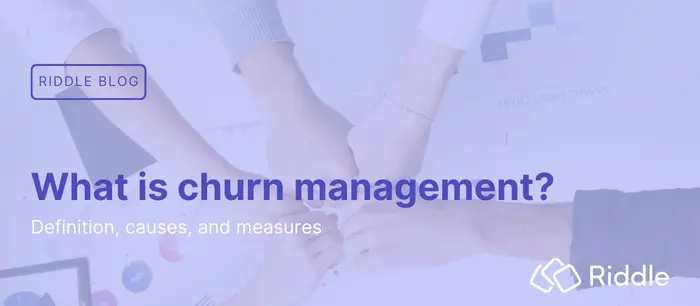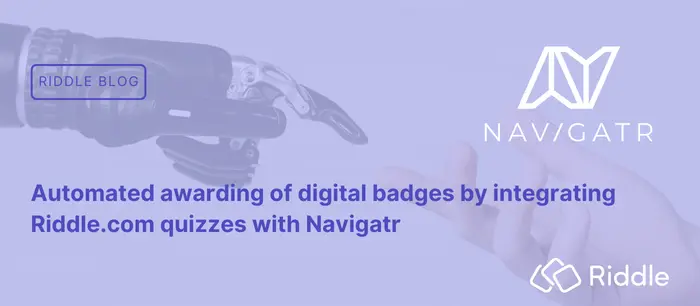Big Five and the OCEAN model
Want to create a ‘Big Five’ personality quiz – centered around the ‘Big Five’ or ‘OCEAN’ model?
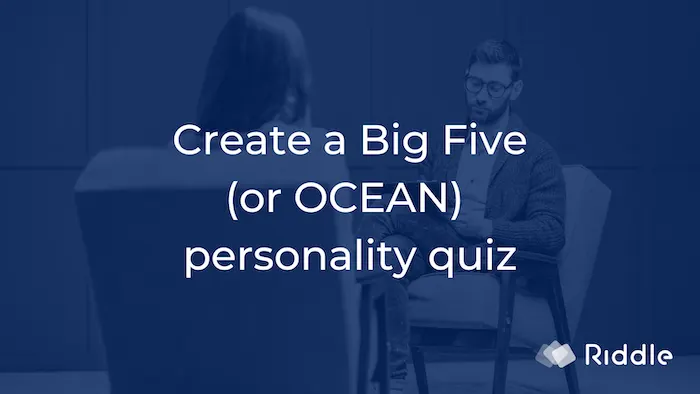
Rooted in psychology, the ‘Big Five’ is based on the five personality traits that capture all core human personalities – from your preferences to mannerisms and behavior.
When you create a ‘Big Five’ personality quiz you should try to represent those traits.
The OCEAN model is similar to creating personality tests using the Enneagram Personality Types.
However, while the Enneagram is a bit more flexible, we recommend the OCEAN model as our preferred model.
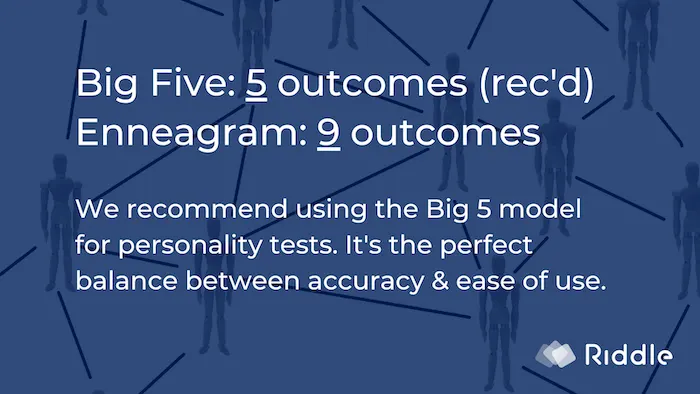
With only five instead of nine outcomes, it’s much easier to create a ‘Big Five’ personality quiz.
But you can also read our post on ‘How to create an enneagram personality test?’.
What does the OCEAN personality test stand for?
This is a classic acronym in the quiz and testing space.
But you’d be surprised – few people actually know the meanings of the letters in the OCEAN personality model.
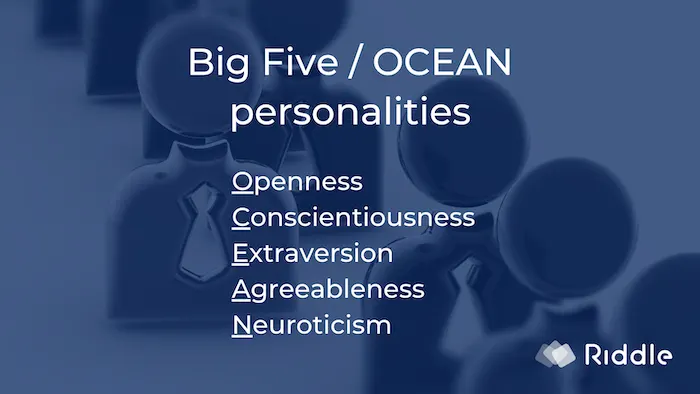
The big five OCEAN personalities are:
- Openness
- Conscientiousness
- Extraversion
- Agreeableness
- Neuroticism
When you create a ‘Big Five’ personality quiz based on this model, it will have a high likelihood of giving quiz taker’s an accurate result.
The challenge when making an OCEAN personality test lies in mapping your desired results to one of these five big personality traits. Use the descriptions and the table below to explore the core personality traits of each result type.
Example ‘Big Five’ personality test – “What breed of dog are you?”
You can take our sample ‘Big Five’ personality test below.
Check out how our questions are both subtle and fun, while gathering enough detail to give each quiz taker an accurate result.
The hard part when you create a ‘Big Five’ personality quiz is coming up with fun, yet insightful questions.
Check out this situational question example for a guide to creating questions as well as answers and scoring:
For example, one of the key statements of someone who scores high on Conscientiousness is “I never forget my belongings”.
- Question: “You are late for a meeting. When you leave your house in a hurry, you…”
- Answer options:
- “Will be right on time – your keys and wallet are right where they are supposed to be.”
- “Need a few minutes to search for your keys and wallet – they never seem to be where you put them the night before!”
- Scoring:
- You could give anyone who selects A) points “Conscientiousness”.
- Everyone who picks B) would not get a score for any of the five personality traits as “losing your belongings” has no straight match with any of them.
- IMPT: Don’t be afraid to not give any points for a certain answer. Even if it does not apply to your ‘Big 5’ personality test results.
Create a ‘Big Five’ personality quiz – start with the results
Right, let’s dive in. When you create a ‘Big Five’ personality quiz, you should start by making the result types first.
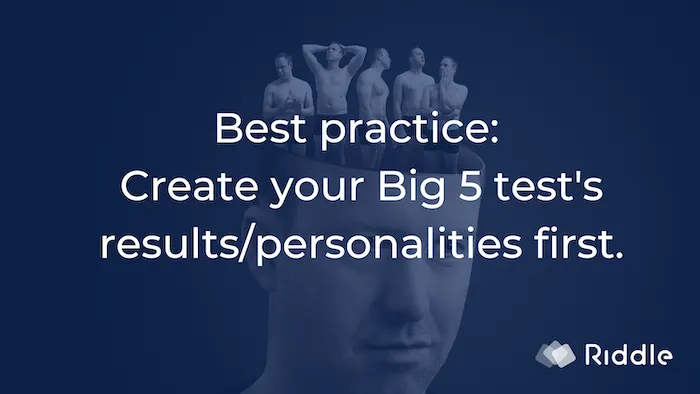
You can use Riddle’s online quiz maker tools for this – our personality test module is designed around the OCEAN model.
How to write good personality test results?
Okay – let’s get into the nitty-gritty about actual crafting good results when you create a ‘Big Five’ personality quiz.
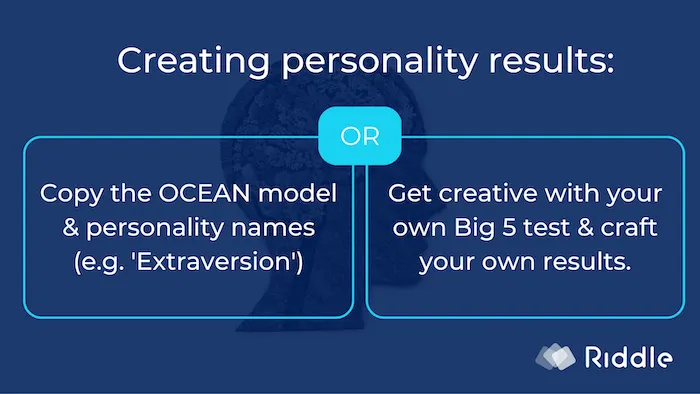
You have two strategies:
- Make your own OCEAN test – you can always just create your own version of the OCEAN personality test, using the same topic and results (e.g. “Openness”, “Neuroticism”, etc.). This doesn’t offer very much flexibility – you are limited to the five original OCEAN results. Since there are many templates online, we won’t cover this in more detail.
- Create your own ‘Big Five’ personality test (recommended) – by far the most flexible and effective option, you can make a quiz around any topic (like our ‘What kind of dog are you?’ or ‘What’s your leadership style?’). You’ll just craft the results around the five overarching OCEAN personality traits – yet give them names that apply to your particular subject.
We’re going to focus entirely on option #2 – it’s much more fun and flexible, plus it applies to the widest range of topics and use cases.
Create (at least) five possible results – similar to the five OCEAN types
Don’t worry – you don’t have to stick to five results for your ‘Big 5’ personality test.
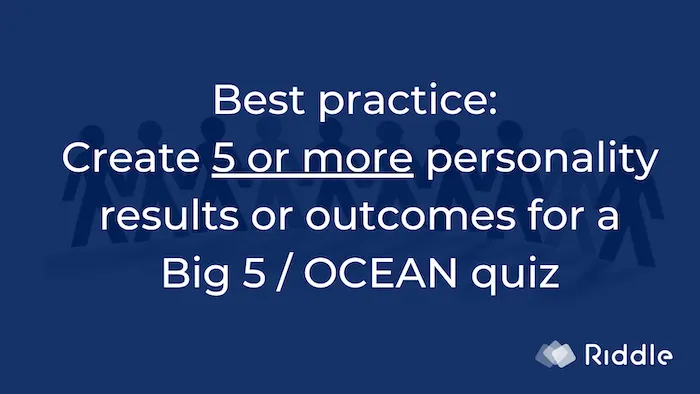
We’ve seen successful tests range from 4-8 results – or even 16 like our ‘What breed of dog are you?’ example.
Two approaches to results when you create a ‘Big 5’ personality quiz
It might sound like the Big 5 personality test model is rigid and inflexible.
But nothing could be further from the truth – check out these two common approaches to creating a successful OCEAN or ‘Big 5’ personality test:
- Be positive (4 results only) – Many quiz creators decide to leave out the “Neuroticism” result type since this trait has a negative vibe.
- If you want to give your audience a purely positive experience, you might not want to include this at all. People tend to not like getting this result – which can mean unhappy quiz takers.
- Combine result types (5 results or more) – People are complicated – and often don’t fall into just one personality type.
- Creating more results means you get to think up results that are a mixture of the five traits.
We did this with our “What breed of dog are you?” example above. - This test has 16 different outcomes, each a mix of 2 or more OCEAN personalities.
- It produces surprisingly accurate results, but was also extremely difficult to create.
- We had a whole team of PhD psychologists help write it – including animal psychology guru Dr. Russ King.
- We then optimized it over several months with tens of thousands of quiz takers.
- Creating more results means you get to think up results that are a mixture of the five traits.
Our suggestion?
Start with exactly five results for your first ‘Big 5’ personality test and find good OCEAN matches for your results.
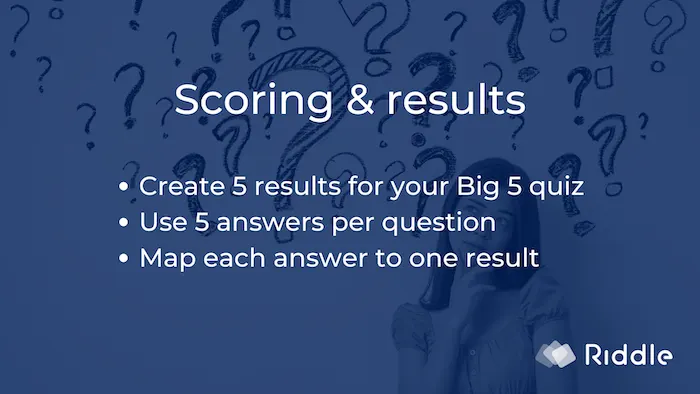
This will help you craft results that test takers will find believable and accurate, giving them insights into their personality.
Create a ‘Big 5’ personality quiz – each trait in detail
When creating a ‘Big 5’ personality test based on the OCEAN personalities, you will need to understand the core traits of every personality – so you can match each core personality trait to your desired results.
We’ve included the key characteristics of each personality, along with some helpful statements that someone with that personality may say about themselves.
Openness
People that rank highly on openness to experience tend to have a general appreciation for art, emotion, adventure, unusual ideas and a variety of experiences.
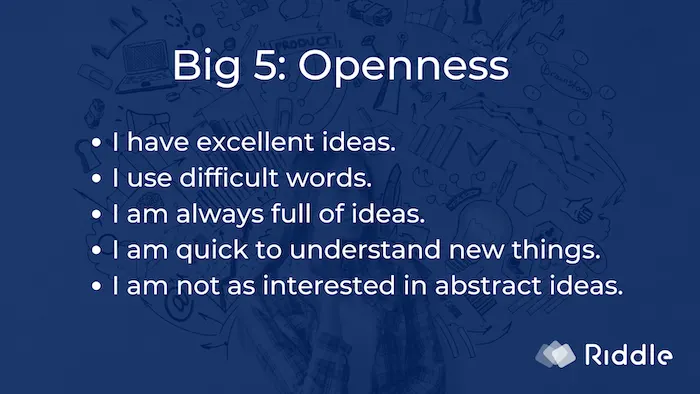
They are intellectually curious, open to emotion and sensitive to beauty. However, while this type of person is willing to try new things, they are often perceived to lack focus.
People who rank highly on ‘Openness’ after you create a ‘Big Five’ personality quiz would tend to classify themselves with these phrases:
- I have excellent ideas.
- I use difficult words.
- I am always full of ideas.
- I am quick to understand new things.
- I am not as interested in abstract ideas.
Conscientiousness
People that score high on conscientiousness have a tendency to display self-discipline, act dutifully and always try to meet other peoples expectations.
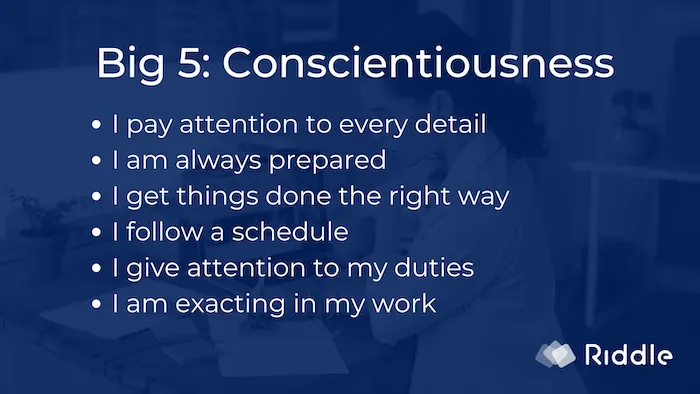
They strive for achievement and display planned rather than spontaneous behaviour. According to the OCEAN model, people who score high on conscientiousness are not very flexible and spontaneous, but are regarded for their reliability by their peers.
They would classify themselves with these phrases:
- I pay attention to every detail
- I like order I am always prepared
- I get things done the right way I follow a schedule
- I never forget my belongings
- I always end up being helpful
- I give attention to my duties
- I am exacting in my work
Extraversion
People that score highly on extraversion on an OCEAN or ‘Big 5’ personality test often enjoy a wide range of activities compared to focusing on just a few things.
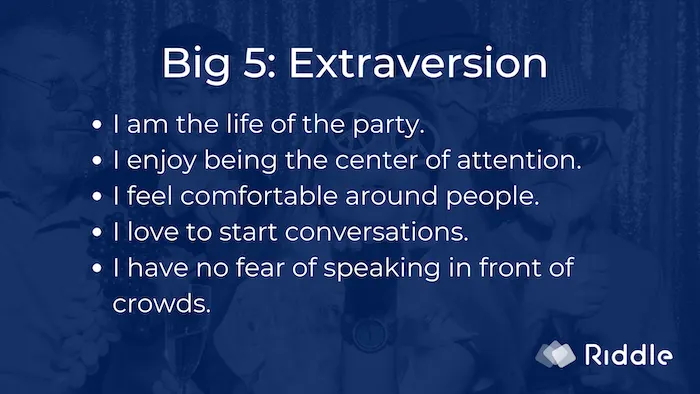
This type of person enjoys interacting with people; they appear to be full of energy, coming across as enthusiastic and action-oriented. In a group, they like to be the ones doing the talking and are highly visible and thus appear to be more dominant in social settings.
They would classify themselves with these phrases:
- I am the life of the party.
- I enjoy being the center of attention.
- I feel comfortable around people and love to start conversations.
- I talk to a lot of people at parties.
- I enjoy drawing attention to myself.
- I have no fear of speaking in front of crowds.
Agreeableness
People that score highly on the OCEAN model’s agreeableness trait place a high value on getting along with others.
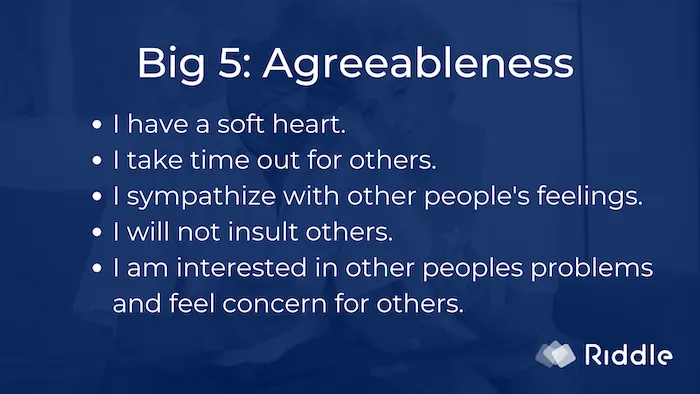
They are considered to be kind, generous, trusting and trustworthy with a marked concern for social harmony.
You’ll find that people who rank for Agreeableness place getting along with others above their own self-interest, and tend to trust and cooperate with others.
They would classify themselves with these phrases:
- I have a soft heart.
- I take time out for others.
- I make people feel at ease and I feel others’ emotions.
- I am interested in people and sympathize with others’ feelings.
- I will not insult others.
- I am interested in other peoples problems and feel concern for others.
Neuroticism
Probably not a surprise, but folks who score high on neuroticism often experience negative emotions such as anxiety, depression or anger.
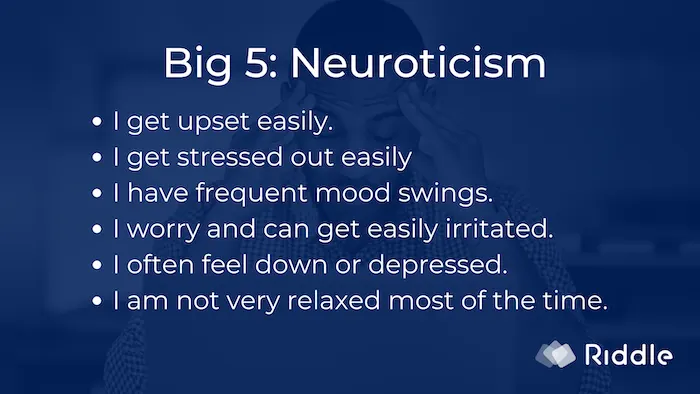
They have a low tolerance for stress and react emotionally. Neurotic people are more likely to interpret ordinary situations as threatening and perceive minor frustrations as hopelessly difficult, which diminishes their ability to make decisions, think clearly and copy effectively with stress.
They would classify themselves with these phrases:
- I get upset easily.
- I get stressed out easily
- I have frequent mood swings.
- I worry about things and get irritated easily.
- I often feel blue.
- I am not very relaxed most of the time.
Writing the questions for the Big 5 personality test
Now that you got your quiz result types covered, you need to come up with compelling questions and answers.
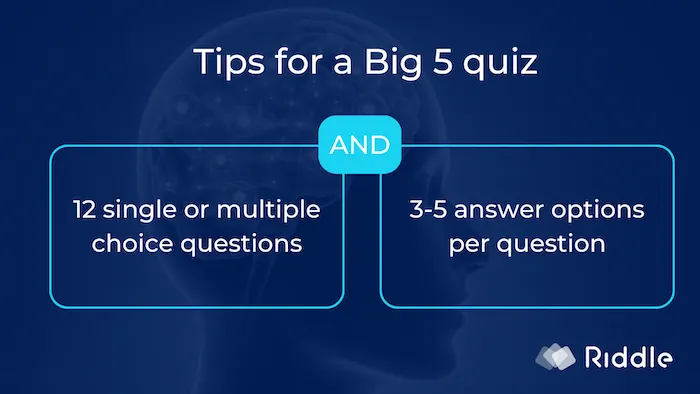
We recommend the following for crafting good questions for the Big 5 personality tests:
- 10-12 questions
- 3-5 answer choices per question
Why? This is just a guideline – but we’ve found:
- > 12 questions: many people start losing interest and leave the quiz before their results.
- < 12 questions: you won’t have enough data to give each possible result type a chance to get sufficient points to be a clear winner.
Remember, this is why we recommend using a personality test maker like Riddle – especially with our new personality test 2.0 (with subtle weighting and branching logic).
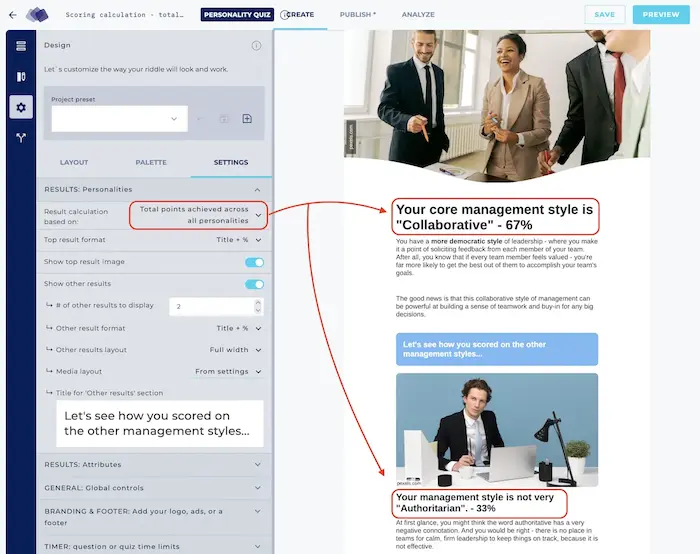
We’re a bit biased of course (it’s our blog, after all) – but seriously, to create a good ‘Big 5’ personality test, you’ll need the flexibility to assign distinct point values to each answer to various results.
Use situational questions in your ‘Big 5’ personality test
Situational questions are both powerful and much more engaging.
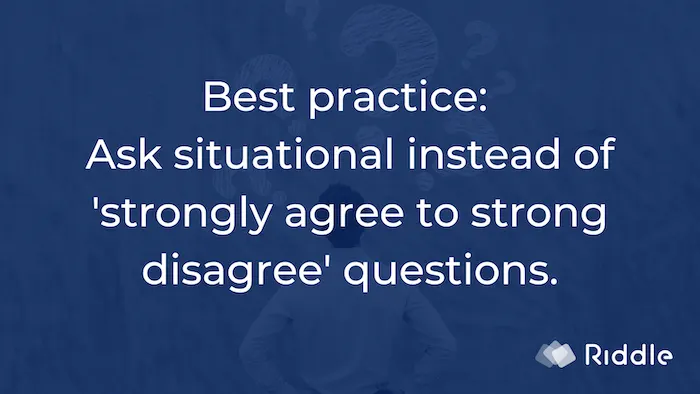
Compare “Where would you be at a crowded cocktail party?” with the typical (and boring) questions “On a scale from not very likely to highly likely, where do your rate yourself” you get on most personality tests.
We’ve found these situations questions work better – they get each test taker to imagine himself in a certain setting. This results in a more accurate answer – especially as it’s a little harder to predict which answers will match to which results.
That’s one of the most significant grumbles we have with the standard ‘strongly disagree to strongly agree’ type of scales – people naturally start to figure out which answers will be scored to which results.
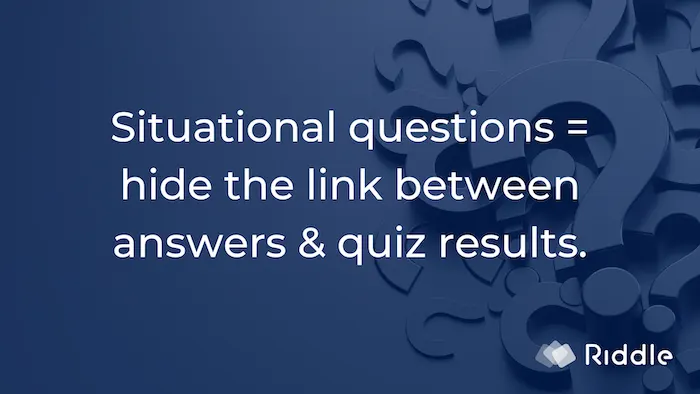
There’s a natural tendency for people to try and ‘game the system’ – to get the most flattering result.
Situational questions are more subtle – and can help hide the link between answer options and result types, giving more accurate overall results for each quiz taker.
Match result types to answer options to create a ‘Big 5’ personality quiz
Right – so you can tell we’re big fans of these types of situational questions. That’s only half the equation, of course.
You next need to come up with insightful answers that can easily be matched with your result types.
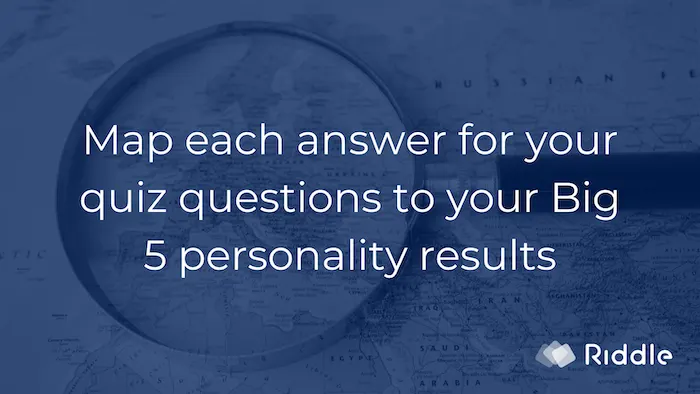
For example, in a “What kind of shoe are you?” example personality quiz, someone answering “Behind the bar, trying new cocktail recipes”:
- Will score high on “Openness” (this mapped to the ‘Beat up old tennis shoe’ result)
- People who rank highly on “Openness” are experimental, creative and open minded.
- This answer option should get 10 points.
But each answer can also map to several different results with varying results.
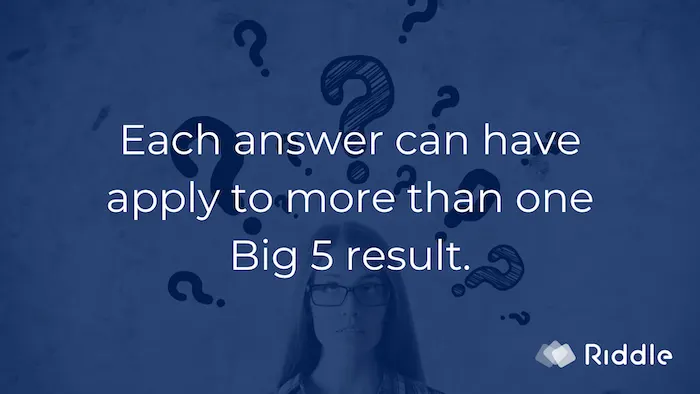
You might decide that choosing “Behind the bar, trying new cocktail recipes” also means you’re showing signs of “Agreeableness”, since “Always willing to help out” is a strong character trait for that OCEAN type.
So in this case, we’re going to assign the ‘Beat up old tennis shoe’ (Openness) result 10 points for this answer, but only 3 points for ‘Fuzzy house slippers’ (Agreeableness).
You can use this model when you create a ‘Big 5’ personality quiz – you’ll be writing questions and answer options in no time.
- Just think of situations where you can present the test taker with reactions that match the result types.
- Be creative and go off-topic – every question doesn’t have to be focused on the main test theme.
- Remember our cocktail example? That has nothing to do with shoes – yet still helps gather insights about the quiz taker.
Adopting this wider range of questions will keep test takers on their toes – and make them wonder how a particular question will relate to their results.
Ask situational questions – both on (and off) topic
We recommend using a mix of 60% on topic and 40% off-topic questions when you create a ‘Big 5’ personality quiz – but keep them 100% situational.
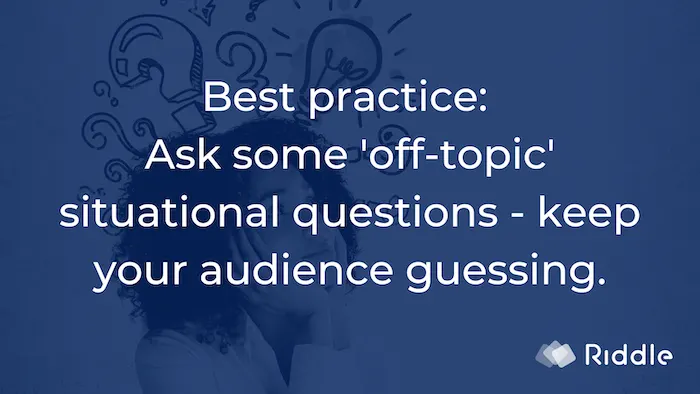
For example, here’s a situational – yet topic-related – question that you could ask:
- Question: You are meeting up with friends for a round of tennis and realize you forgot your tennis shoes. What do you do?
- Answer Options:
- Tell my friends to get started, while I rush home to get my tennis shoes. Gotta have the right shoes to play (Conscientious)
- Play with whatever shoes I am wearing right now, worst case making fun of myself when slipping and sliding around the court (Openness)
- Play barefoot (Extraversion)
- Afraid to hold up my friends, I will tell them to get on with their game, while I just watch from the sidelines (Neuroticism)
Scoring your ‘Big 5’ personality test
Riddle’s quiz maker gives you a scale from zero to twenty points for each answer option.
You assign points for each answer across one (or many) result types – the quiz taker receives the result with the most points.
You can also show users how they did on the other personality results with our ‘extended personality results’ feature.
For example – in this ‘What’s your management style’ personality test, user A might get “Authoritative” as their result in your ‘Big 5’ personality test.
However, you could also show they got 55% “Mentoring”, 38% “Collaborative”, and so on.
We find that boosts engagement and sharing – people enjoy finding not just their main result, but how they scored across all of the other possibilities.
Balancing the results when you create a ‘Big 5’ personality quiz
When creating a test, make sure that each of your OCEAN results has an equal chance to win.
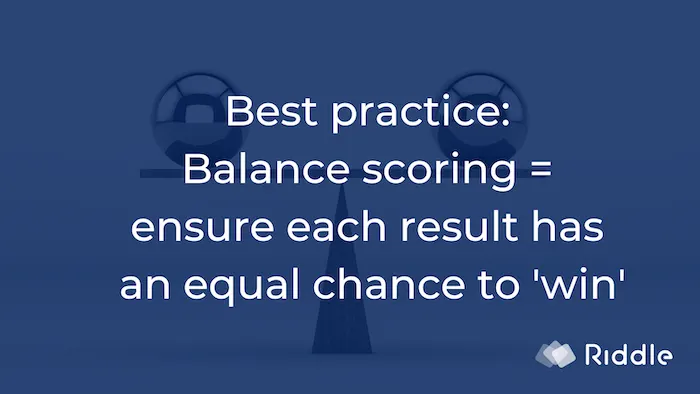
- Tally up the potential points for each results and check if each of the results have roughly the same potential points.
- It’s easy to end up with one result that has a disproportionate share of the possible points – which means too many quiz takers will get that result, and it won’t feel accurate.
- Balancing each result type is much easier when creating a personality test with five results vs. one that has 16 results.
You can check the balance in our score configurator modal.
More tips for scoring and results:
- Use 0-10 points: we recommend using your scoring range as 0-10 points for most results option.
- Save the maximum 20 points for ‘extremely strong’ indicators: This should be your ‘big gun’ – used only when a particular answer option means someone is definitely that result type.
- If you assign the full 20 points for a certain result, it’s almost certain to give the quiz taker that result in a typical 10 or 12 question test.
Lastly – test, test, test your personality quiz
Okay – when you’re finished with all the creation and balancing of potential results, it can be tempting to just click publish and share your ‘Big 5’ personality test.
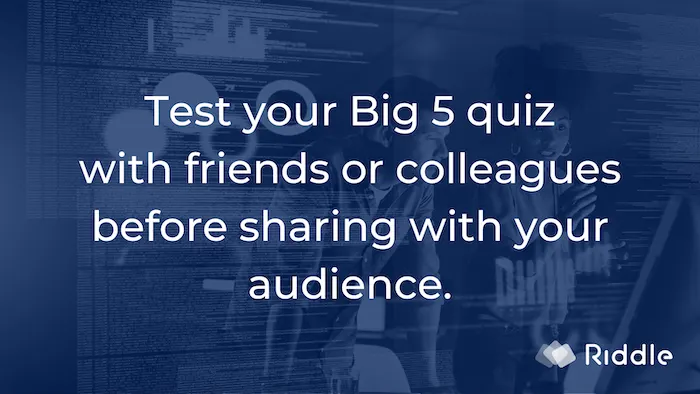
But the last step to create a ‘Big 5’ personality quiz?
We highly, highly recommend giving it a couple of run-throughs – to make sure everything looks and feels ‘right’.
When you do your practice test takes, answer the questions trying to get a particular result. Make sure that the outcome you get is what you aimed for.
If you’re not getting the OCEAN result you were trying for, check your scoring.
You probably have one question where the answer options give too many points to a particular result type.
Another good tip? Get a few of your friends to take your Big 5 personality test as well – they’ll be fresh eyes, and might spot some areas to improve.
Further reading at OCEAN personality tests
Brace yourself (and get some coffee) – crafting a really good, highly insightful personality test around the big five personality traits can be a challenge.
Sure, the mechanics to create a ‘Big 5’ personality quiz are easy, especially using our online quiz maker.
However, there’s an art and science to creating really good personality tests (check out this handy guide from our chief quiz guru). We also highly recommend listening to the Science Versus podcast episode on personality tests where host Wendy Zukerman shows research that the big five personality test outperforms the Myers Briggs and the Enneagram test when it comes to classifying personalities.
It’s worth it – personality tests have the best lead generation opt-in and social share rates of our 15 Riddle interactive content formats.
Additional resources:
We’ve found these are great resources to help you learn more about the psychology behind the ‘Big Five OCEAN’ personality tests:
- Wikipedia – Summary of the big five personality traits
- Healthline – What the big five personality traits can tell you?
- Positive Psychology – The big five personality theory
- Riddle – how a color quiz can tell you which car your users would buy
- Likert scale quiz – A bit different from the OCEAN test, but a good alternative to mention
- University of Oregon, Department of Psychology – The Big-Five Trait Taxonomy
Any questions about how to create a ‘Big 5’ personality quiz? Just ask us!
If you want to learn more on how to create your own big five / OCEAN personality test with riddle.com, reach out to us via support chat or by email (hello@riddle.com).
Good luck with your OCEAN test!

